
The 12e Régiment blindé du Canada is a Canadian Army armoured regiment based in CFB Valcartier, on the outskirts of Quebec City. The regiment has both a Regular Force and a Primary Reserve unit. The 12e Régiment blindé du Canada's abbreviation is 12e RBC.

The Governor General's Horse Guards is an armoured cavalry regiment in the Primary Reserve of the Canadian Army. The regiment is part of 4th Canadian Division's 32 Canadian Brigade Group and is based in Toronto, Ontario. It is the most senior reserve regiment in Canada, and the only household cavalry regiment of Canada's three household units.

The Canadian Grenadier Guards (CGG) is a reserve infantry regiment in the 34 Canadian Brigade Group, 2nd Canadian Division, of the Canadian Army. The regiment is the oldest and second-most-senior infantry regiment in the Primary Reserve of the Canadian Army. Located in Montreal, its main role is the provision of combat-ready light infantry troops in support of Canadian regular infantry. It is a Household Foot Guard regiment and also provides soldiers for public ceremonial duties, performing similar ceremonial duties as the Guards regiments of the British Army. This primarily entails mounting the guard at Government House, the Governor General's residence, and performing the "Changing the Guard" ceremony on Parliament Hill in Ottawa, a task it shares with Canada's senior Household Foot Guard regiment, the Governor General's Foot Guards of Ottawa. The Canadian Grenadier Guards is an allied regiment to the British Grenadier Guards.

The Royal Canadian Dragoons (RCD) is the senior armoured regiment of the Canadian Army by precedence. It is one of three armoured regiments in the Regular Force and forms part of the Royal Canadian Armoured Corps.
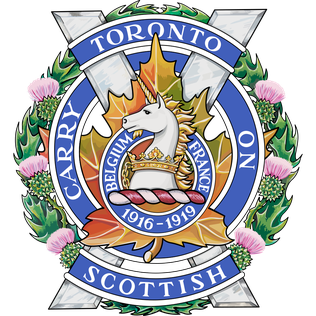
The Toronto Scottish Regiment (Queen Elizabeth The Queen Mother's Own) is a Primary Reserve infantry regiment of the Canadian Army based in Toronto, Ontario, Canada. The regiment was first formed in 1915 as the 75th (Mississauga) Battalion, CEF, and was later reorganized several times before being officially designated as The Toronto Scottish Regiment (Queen Elizabeth The Queen Mother's Own).

The Ontario Regiment (RCAC) is a Primary Reserve armoured reconnaissance regiment of the Canadian Army. The unit is based in downtown Oshawa, Ontario, and is named after Ontario County (1852–1973). Formed in 1866, and more commonly known as the 'Ontarios', 'black cats' or 'ONT R' (pronounced "ON-tar"), the regiment ranks among the oldest continuously serving Reserve (Militia) regiments in Canada and is one of the senior armoured regiments in the Royal Canadian Armoured Corps.
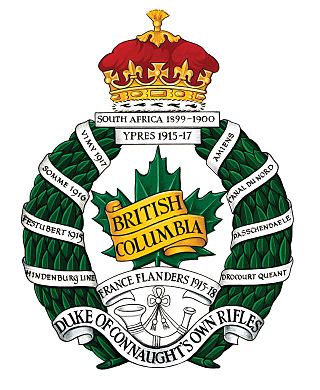
The British Columbia Regiment (Duke of Connaught's Own) is a Primary Reserve armoured reconnaissance (recce) regiment of the Canadian Army; the regiment is subordinate to 39 Canadian Brigade Group of the 3rd Canadian Division. Established in 1883, it is the oldest military unit in Vancouver, British Columbia, Canada. It parades at the Beatty Street Drill Hall at the corner of Dunsmuir and Beatty in Downtown Vancouver. The regiment has been variously designated as garrison artillery, rifles, infantry, and armoured, but has been reconnaissance since 1965. It has received 41 battle honours in its history, and has been a unit of the Royal Canadian Armoured Corps since 1942.
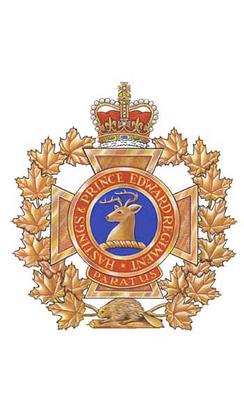
The Hastings and Prince Edward Regiment is a Primary Reserve infantry regiment of the Canadian Army. The regiment is part of 33 Canadian Brigade Group, one of four brigade groups of 4th Canadian Division. The regimental headquarters and one company are at 187 Pinnacle Street in Belleville and on Willmott Street in Cobourg, with another rifle company in Peterborough. The Peterborough Armoury houses what was traditionally B Company or Moro Company. Moro Company also serves as the headquarters for the regiment’s Assault Pioneer Platoon. Normally, the regiment deploys as a composite, Ortona Company, while the headquarters and administration form Somme Company.

The Royal Montreal Regiment is a Primary Reserve infantry regiment of the Canadian Army based in Westmount, Quebec. It is part of the 2nd Canadian Division's 34 Canadian Brigade Group.
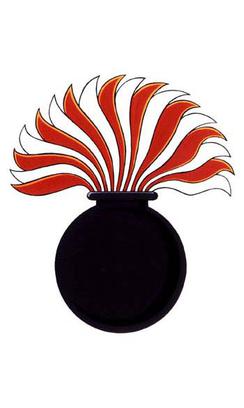
The Winnipeg Grenadiers was an infantry regiment of the Canadian Army.

Les Fusiliers de Sherbrooke is a Primary Reserve infantry regiment of the Canadian Army. It is based in Sherbrooke, Quebec, with a sub-unit in Granby.

The 12th Manitoba Dragoons is an armoured regiment of the Canadian Army that is currently on the Supplementary Order of Battle.

The 19th Alberta Dragoons was a cavalry regiment and later an armoured regiment of the Canadian Militia and later the Canadian Army. It was placed on the Supplementary Order of Battle in 1965. In 2006, it was taken off the Supplementary Order of Battle and amalgamated with the South Alberta Light Horse.

The Royal Rifles of Canada was a rifle regiment in the Canadian Army and fought alongside The Winnipeg Grenadiers in the Battle of Hong Kong during World War II. In November 1966, it was reduced to nil strength and placed on the Supplementary Order of Battle.

The 14th Canadian Hussars was a light cavalry and later light armoured reconnaissance regiment of the Non-Permanent Active Militia of the Canadian Militia and later the Canadian Army. First raised in 1910 as the 27th Light Horse, the regiment was Redesignated in 1920 as the 14th Canadian Light Horse and again in 1940 as the 14th Canadian Hussars. On 31 March 1968, the regiment was reduced to nil strength and placed on the Supplementary Order of Battle.
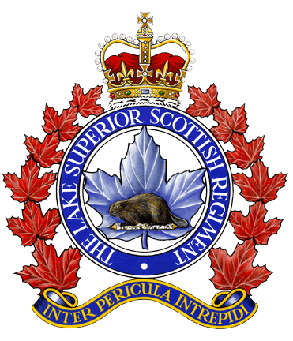
The Lake Superior Scottish Regiment is a Primary Reserve infantry regiment of the Canadian Forces. The regiment is located in Thunder Bay, Ontario, and is part of the 3rd Canadian Division's 38 Canadian Brigade Group. Also known as "The Lake Sups" (pronounced soups), the regiment was active during the First and Second World Wars. During the latter, the regiment, then known as The Lake Superior Regiment or LSR, mobilized a motorized infantry battalion for the 4th Canadian (Armoured) Division; The Lake Superior Regiment (Motor) or LSR(M).
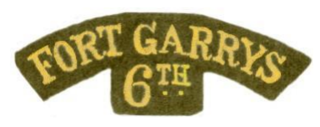
The 6th Battalion, CEF was a battalion of the Canadian Expeditionary Force during the First World War.
The Manitoba Horse was a cavalry regiment of the Non-Permanent Active Militia of the Canadian Militia. First formed in 1912 as the 32nd Light Horse, the regiment was redesignated later that same year as the 32nd Manitoba Horse and again in 1920 as The Manitoba Horse. In 1936, the regiment was amalgamated with The Fort Garry Horse.
The Manitoba Mounted Rifles was a cavalry regiment of the Non-Permanent Active Militia of the Canadian Militia and later the Canadian Army. In 1946, the regiment was converted to artillery.
The Saskatchewan Mounted Rifles was a cavalry regiment of the Non-Permanent Active Militia of the Canadian Militia. First formed in 1908 as the Saskatchewan Light Horse, the regiment was later redesignated that year as the 22nd Saskatchewan Light Horse and again in 1920 as The Saskatchewan Mounted Rifles. In 1911, the regiment transferred two of its squadrons to the newly formed 29th Light Horse. In 1936, the regiment was amalgamated with the 16th Canadian Light Horse to form the 16th/22nd Saskatchewan Horse.





















